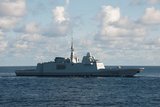US Army deploys Kestrel Eye microsatellite
The US Army’s Kestrel Eye microsatellite prototype was deployed into space from the International Space Station (ISS) and activated on 24 October.
The microsatellite was launched as part of an ISS cargo resupply mission in August. Now deployed at a safe distance from ISS, the satellite will power up automatically and begin receiving signals from the ground station.
The Kestrel Eye is a small, low-cost, visible-imagery satellite designed to provide rapid situational awareness directly to army brigade combat teams by providing satellite imagery without the need for conventional, continental US-based relays. It is intended to be tactically responsive, with the ability to task and receive data during an overhead pass and provide a measure of satellite persistence overhead that can provide situational awareness and images rapidly to the soldier.
The army will use the satellite to investigate the possibility of giving commanders in the field the ability to control the entire imagery process from end-to-end, from the tasking of the satellite all the way through to the dissemination of the data to the soldiers who need it.
The deployment will be carried out over four stages. The first phase is a technical checkout to verify satellite functionality and make any adjustments; while the second is a technical demonstration of the satellite to demonstrate its full capability.
The third phase is an operational demonstration that will see a limited military utility assessment conducted by the independent assessor, Space and Naval Warfare Systems Command. This will be followed by residual operations where Kestrel Eye will participate in a series of army exercises.
More from Digital Battlespace
-
![Babcock nears first customer for Nomad AI translation tool]()
Babcock nears first customer for Nomad AI translation tool
Nomad can provide militaries with real-time intelligence, saving critical time on the battlefield.
-
![AUSA 2025: Israel’s Asio Technologies to supply hundreds of improved Taurus tactical systems]()
AUSA 2025: Israel’s Asio Technologies to supply hundreds of improved Taurus tactical systems
Taurus operates alongside the Israel Defense Forces’ Orion system which supports mission management across tens of thousands of manoeuvring forces, from squad leaders to battalion commanders.
-
![AUSA 2025: Kopin pushes micro-LED plans as China moves faster]()
AUSA 2025: Kopin pushes micro-LED plans as China moves faster
The plan for the new displays follows fresh investment in Kopin’s European facilities by Theon and an order for head-up displays in fielded aircraft, with funding from the US Department of Defense.
-
![AUSA 2025: Persistent Systems to complete its largest order by year’s end]()
AUSA 2025: Persistent Systems to complete its largest order by year’s end
Persistent Systems received its largest ever single order for its MPU5 devices and other systems earlier this month and has already delivered the 50 units to the US Army’s 4th Infantry Division.
-
![Aselsan brings in dozens of companies and systems under the Steel Dome umbrella]()
Aselsan brings in dozens of companies and systems under the Steel Dome umbrella
Turkey has joined the family of countries attempting to establish a multilayered air defence system with government approval in August 2024 for the effort landed by Aselsan. Dubbed Steel Dome, the programme joins Israel’s Iron Dome, the US Golden Dome, India’s Mission Sudarshan Chakra and South Korea’s low-altitude missile defence system.
-
![DSEI 2025: MARSS unveils new agnostic multidomain C4 system]()
DSEI 2025: MARSS unveils new agnostic multidomain C4 system
MARSS’ NiDAR system has been deployed using sensors from static platforms to provide detection and protection for static sights, such as critical infrastructure, ports and military bases.



























